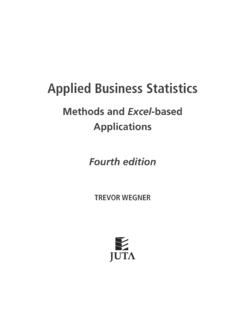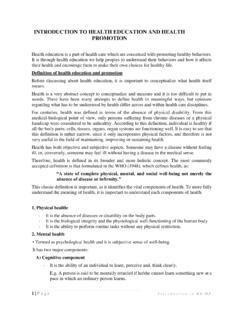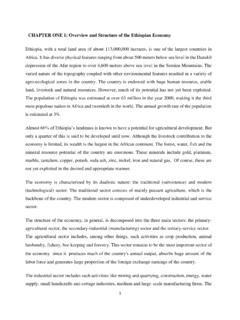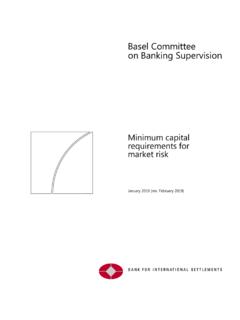Transcription of Mekelle University College of Business and Economics ...
1 Mekelle University College of Business and Economics Department of Accounting and Finance Course Name Investment Analysis and Portfolio Management Course Code AcFn 3201 By: Dr. Bereket Zeray Haftom G/micheal April 2020 Mekelle , Ethiopia Mekelle University Collage of Business and Economics Department of Accounting and Finance Course Information Course code AcFn3201 Course Title Investment and Portfolio Management Degree Program BA Degree in Accounting and Finance Module Project and Investment Analysis Module no and code M20 ; AcFn-M3201 Module Coordinator Lecturer and Haftom, ETCTS Credits 3 Contact Hours (per week) 2 Course Objectives The course will enable students to understand different investment avenues and aware of the risk return of different investment alternatives and estimate the value of securities so as to make valuable investment decisions.
2 Course Description This course provides an overview of the field of investment .it explains basic concepts and methods useful in investment. The course also tries to imitate the valuation of bond and stocks. It also covers fundamental and technical analysis as well as portfolio construction and portfolio managements. WEEKS Course Contents 1. Introduction to investment What is investment Investment alternatives Investment companies Security market 2. Risk and return Return Risk Measuring historical risk Measuring historical return Measuring expected risk and return 3. Fixed income securities a. Bond characteristic b. Bond price c. Bond yield d. risks in bond e. Rating of bonds f. Analysis of convertible bonds 4. Stock and equity valuation Stock characteristic Balance sheet valuation Dividend discount model Free cash flow model Earning multiplier approach 5.
3 Security analysis Macro-economic analysis Industry analysis Company analysis Technical analysis 6. Portfolio theory Diversification and portfolio risk Portfolio risk and return Capital allocation between risky and risk free assets Optimum risky portfolio 7. Portfolio Management Portfolio performance evaluation The process of portfolio management Risk management and hedging Active portfolio management International portfolio management 4 Teaching & Learning Methods/strategy The teaching and learning methodology include lecturing, discussions, problem solving, and analysis. Take-home assignment will be given at the end of each chapter for submission within a week. Solution to the assignments will be given once assignments are collected. Cases with local relevance will also be given for each chapter for group of students to present in a class room.
4 The full and active participation of students is highly encouraged. Assessment/Evaluation The evaluation scheme will be as follows: Test 1 Test 2 Test 3 Quiz1 Assignment 1 Final Total 10% 10% 15% 5% 10% 50% 100% Text and reference books Text Book: Chandra, P. Investments Analysis Portfolio management. 3rd Reference Books Bodie, Kane & Marcus. Investments. 4th Elton, Guruber, Modern Portfolio Theory and Investment Analysis. 5th Avadhani, Security Analysis and Portfolio Management. 9th 5 Chapter One Introduction to investment What is an Investment? When current income exceeds current consumption desires, people tend to save the excess. They can do any of several things with these savings.
5 One possibility is to put the money under a mattress or bury it in the backyard until some future time when consumption desires exceed current income. When they retrieve their savings from the mattress or backyard, they have the same amount they saved. Another possibility is that they can give up the immediate possession of these savings for a future larger amount of money that will be available for future consumption. This tradeoff of present consumption for a higher level of future consumption is the reason for saving. What you do with the savings to make them increase over time is investment Those who give up immediate possession of savings (that is, defer consumption) expect to receive in the future a greater amount than they gave up. Conversely, those who consume more than their current income (that is, borrow) must be willing to pay back in the future more than they borrowed.
6 The rate of exchange between future consumption (future dollars) and current consumption (current dollars) is the pure rate of interest. Both people s willingness to pay this difference for borrowed funds and their desire to receive a surplus on their savings give rise to an interest rate referred to as the pure time value of money. This interest rate is established in the capital market by a comparison of the supply of excess income available (savings) to be invested and the demand for excess consumption (borrowing) at a given time. If you can exchange $100 of certain income today for $104 of certain income one year from today, then the pure rate of exchange on a risk-free investment (that is, the time value of money) is said to be 4 percent (104/100 1). The investor who gives up $100 today expects to consume $104 of goods and services in the future.
7 This assumes that the general price level in the economy stays the same. For instance in US the price stability has rarely been the case during the past several decades when inflation rates have varied from percent in 1986 to percent in 1979, with an average of about percent a year from 1970 to 2001. If investors expect a change in prices, they will require a higher rate of return to compensate for it. For example, if an investor expects a rise in prices (that is, he or she expects inflation) at the rate of 2 percent during the period of investment, he or she will increase the required interest rate by 2 percent. In our example, the investor would require $106 in the future to defer the $100 of consumption during an inflationary period (a 6 percent nominal, risk-free interest rate will be required instead of 4 percent). 6 Further, if the future payment from the investment is not certain, the investor will demand an interest rate that exceeds the pure time value of money plus the inflation rate.
8 The uncertainty of the payments from an investment is the investment risk. The additional return added to the nominal, risk-free interest rate is called a risk premium. In our previous example, the investor would require more than $106 one year from today to compensate for the uncertainty. As an example, if the required amount were $110, $4, or 4 percent, would be considered a risk premium. From our discussion, we can specify a formal definition of investment. Specifically, an investment is the current commitment of dollars for a period of time in order to derive future payments that will compensate the investor for i. the time the funds are committed, ii. the expected rate of inflation, and iii. The uncertainty of the future payments. The investor can be an individual, a government, a pension fund, or a corporation.
9 Similarly, this definition includes all types of investments, including investments by corporations in plant and equipment and investments by individuals in stocks, bonds, commodities, or real estate . The investor is trading a known dollar amount today for some expected future stream of payments that will be greater than the current outlay. Why people invest and what they want from their investments. They invest to earn a return from savings due to their deferred consumption. They want a rate of return that compensates them for the time, the expected rate of inflation, and the uncertainty of the return. This return, the investor s required rate of return, is discussed throughout this course. A central question of this course is how investors select investments that will give them their required rates of return. MEASURES OF RETURN AND RISK A return is the ultimate objective for any investor.
10 But a relationship between return and risk is a key concept in finance. As finance and investments areas are built upon a common set of financial principles, the main characteristics of any investment are investment return and risk. However to compare various alternatives of investments the precise quantitative measures for both of these characteristics are needed. With most investments, an individual or Business spends money today with the expectation of earning even more money in the future. The concept of return provides investors with a convenient way of expressing the financial performance of an investment. Many investments have two components of their measurable return: a capital gain or loss; Some form of income. 7 The rate of return is the percentage increase in returns associated with the holding period: Measures of Historical Rates of Return: If you commit $200 to an investment at the beginning of the year and you get back $220 at the end of the year, what is your return for the period?















